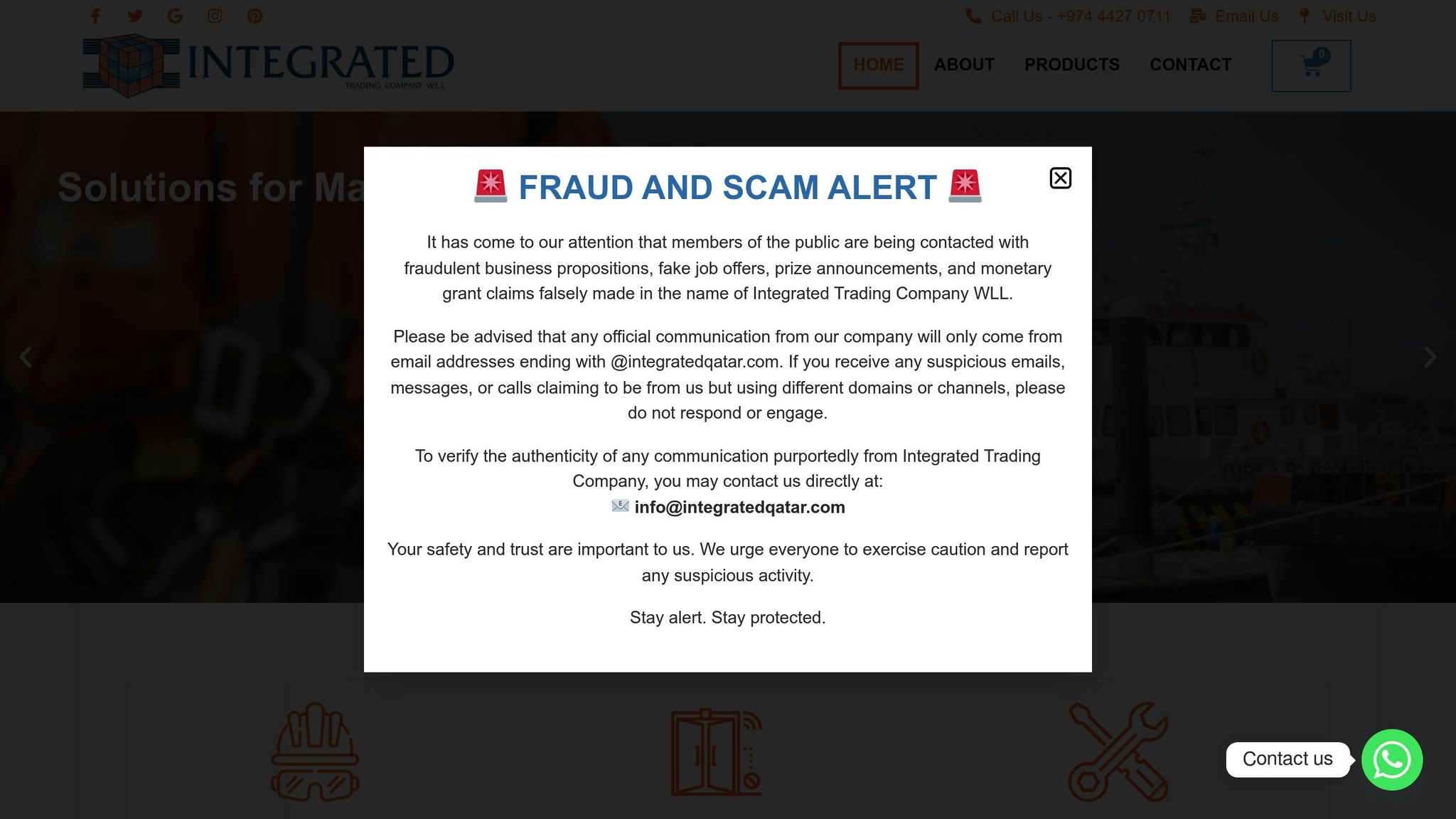
Healthcare safety equipment is critical for protecting medical staff and patients from infections, injuries, and workplace hazards. This guide covers key topics like the importance of PPE, Qatar’s safety regulations, and advanced technologies used in healthcare facilities. It also highlights challenges such as PPE shortages, discomfort, and low adherence to safety protocols. Here’s a quick overview:
This guide also emphasizes proper PPE selection, maintenance, and disposal, alongside the role of suppliers like Integrated Trading Company W.L.L in addressing safety needs effectively. Healthcare professionals must focus on training, regular audits, and maintaining equipment to ensure safety and compliance.
PPE acts as a vital shield for healthcare workers, safeguarding them from hazards like blood, bodily fluids, and airborne contaminants. It ensures the safety of both medical staff and patients. However, achieving consistent use remains a challenge. A study in Qatar found that only 49.7% of healthcare workers fully adhered to PPE guidelines during the COVID-19 pandemic. This underscores the importance of understanding the types of PPE, how to choose the right equipment, and proper usage protocols.
Healthcare PPE includes several key categories, each tailored to protect against specific risks. Knowing their individual roles helps professionals make informed choices based on the situation.
Understanding these tools and their specific purposes is a critical step in ensuring proper protection.
In Qatar, choosing the right PPE involves aligning with local regulations and balancing safety, comfort, and practicality within healthcare settings.
Proper use, upkeep, and disposal of PPE are essential for ensuring ongoing protection and meeting regulatory standards.
A well-rounded PPE program integrates proper selection, thorough training, consistent maintenance, and environmentally responsible disposal. This approach not only ensures maximum safety for healthcare workers but also aligns with Qatar’s safety regulations.
In Qatar’s state-of-the-art healthcare facilities, safety goes beyond personal protective equipment (PPE). Advanced technologies are embedded into hospital infrastructure to ensure the well-being of both patients and staff.
Maintaining clean air is crucial in healthcare settings, especially in Qatar, where climate factors can pose challenges. Hospitals rely on medical-grade HEPA filters, such as H13 and H14, which outperform lower-grade filters like H10–H12 in capturing airborne particles. In 2023, these filters led the hospital filtration market, capturing a 37.92% revenue share. The global hospital air purifier market is expected to hit USD 14.79 billion by 2030, growing at a steady 8.50% annually. Qatar alone accounted for 20.8% of the GCC air purifier market in 2023.
“Maintaining high air quality in clinical settings is essential to safeguard patient and staff health, particularly in dental clinics where procedures generate airborne contaminants.”
– Al Sharyani, Alzahra et al.
CosaTron systems stand out by actively increasing airborne particle size, making them easier to trap, unlike traditional HEPA filters that rely on passive filtration. According to CosaTron:
“The most effective air purification systems for infection control in hospitals are those that provide comprehensive air cleaning coverage, capable of removing a wide range of airborne pathogens and contaminants.”
– CosaTron
Regular maintenance, such as cleaning or replacing filters and monitoring system performance, is vital to ensure these technologies function at peak efficiency. Many hospitals are also integrating these systems into their existing HVAC setups to enhance filtration without major overhauls.
Manufacturers continue to develop cutting-edge solutions tailored to healthcare needs. For instance, Camfil USA introduced advanced HEPA H14 filters in March 2023 to combat airborne pathogens. Likewise, MANN+HUMMEL launched modular HEPA-based clean air systems for hospitals in 2023 and expanded their offerings with the SafeAir Lab system for laboratories in 2024.
While clean air ensures environmental safety, access control systems safeguard physical spaces. Protecting sensitive areas like operating rooms, ICUs, medical storage, and data centers is critical. Alarmingly, over 70% of medication tampering, fraud, and theft incidents occur in healthcare facilities. Additionally, data breaches cost healthcare organizations an average of USD 11 million in 2023.
Modern access control systems employ RFID, biometrics, PIN codes, and mobile credentials to restrict unauthorized entry into high-risk areas.
“Access control is paramount for securing sensitive and protected resources. Failure to properly manage access can have a huge impact on costs, brand damage or even operational downtime.”
– Wes Gyure, Executive Director of Product Management, IBM Security
Role-based access control (RBAC) adds another layer of protection by limiting access strictly to individuals based on their job responsibilities. To ensure these systems are effective, healthcare administrators should monitor access logs, perform regular audits, and train staff on emergency protocols. For instance, a private hospital in Al Wakrah uses Suprema BioLite fingerprint terminals to restrict ICU and storage room access to authorized personnel only.
The best safety outcomes come from integrating multiple technologies into a unified system. Combining air filtration systems with access control solutions allows hospitals to address both airborne and physical threats. Centralized systems streamline monitoring and enable quicker responses during emergencies.
Modern access control systems can connect with fire alarms and evacuation protocols, automatically unlocking doors while maintaining security logs. Similarly, air filtration systems can adapt their performance based on occupancy data from access control systems, optimizing both air quality and energy use.
By merging these technologies, healthcare facilities create a layered safety approach that strengthens their overall protocols. To maximize the effectiveness of these integrated systems, hospitals should establish clear administrative policies, provide ongoing security training, and conduct regular audits to assess performance.
These advanced technologies complement PPE measures, forming a robust safety framework that aligns with Qatar’s commitment to world-class healthcare standards.
Healthcare facilities in Qatar are required to meet stringent regulations aimed at ensuring top-tier patient care and safety. Over the years, Qatar’s healthcare system has significantly advanced in both safety and quality, aligning with the goals outlined in Qatar’s National Vision 2030. This vision prioritises a healthy population as a cornerstone of national progress. As highlighted by Qatar’s Ministry of Public Health:
“Qatar’s robust healthcare regulations are crucial in ensuring the highest standards of patient care, safety, and professionalism across the country”.
The compliance framework serves as the foundation for the safety measures discussed in the following sections.
Hazard assessments are a critical element of healthcare safety compliance in Qatar. Healthcare facilities are required to perform thorough Health Risk Assessments (HRAs) to pinpoint potential risks, evaluate their severity, and implement effective control measures. This is particularly important given that the healthcare and social assistance sector saw a 40% rise in reported injury cases in 2020.
The process involves identifying hazards across several categories: physical, chemical, biological, ergonomic, and psychosocial. Facilities evaluate these risks using a variety of tools, such as workplace inspections, exposure assessments, noise and air quality testing, chemical monitoring, heat stress evaluations, and ergonomic analyses. The Hazard Identification and Risk Assessment (HIRA) method provides a structured approach for these evaluations.
To mitigate risks, facilities are encouraged to follow the hierarchy of controls, which prioritises engineering solutions, administrative measures, and personal protective equipment. Additionally, emergency response procedures must be developed to ensure swift and effective actions during incidents.
After identifying and addressing hazards, regular audits are vital to ensure that safety measures remain effective. Internal audits, conducted routinely, focus on areas such as documentation, staff training records, equipment maintenance logs, and incident reports to detect any compliance gaps. Maintaining detailed records of training sessions, including attendees, dates, and topics, is crucial for demonstrating compliance.
External inspections, carried out by Qatar’s Ministry of Public Health, evaluate healthcare facilities on licensing, accreditation, patient safety protocols, and quality control systems. To prepare for these inspections, facilities must compile evidence of ongoing compliance. In the pharmaceutical sector, Qatar’s track and trace initiative mandates that pharmaceutical products adhere to GS1-compliant serialisation standards, including 2D DataMatrix barcodes with unique serial numbers, to ensure full supply chain transparency.
Audit findings should be addressed promptly through corrective action plans. Strong document control systems are essential for keeping records up-to-date with regulatory changes. Regular internal audits further reinforce compliance and readiness for external evaluations.
Training is a cornerstone of meeting Qatar’s healthcare safety standards. All healthcare personnel must undergo training tailored to their specific workplace and equipment to ensure proper adherence to safety protocols.
However, challenges remain. A survey conducted in Qatar during the COVID-19 pandemic revealed that only 44.1% of healthcare workers fully adhered to infection prevention and control measures, though 83.1% complied with hand hygiene practices. These figures highlight the ongoing need for consistent training and monitoring.
Workshops and the adoption of a Quality Management System aligned with ISO 13485 can help ensure training programmes meet both international standards and Qatar’s regulatory requirements. Proper documentation not only demonstrates compliance but also mitigates legal and financial risks, streamlines audits, and enhances operational transparency. Facilities should regularly train employees on compliance policies, conduct frequent internal audits, and maintain updated records in line with regulatory requirements. This comprehensive approach enables healthcare providers in Qatar to uphold safety standards while fostering a culture of continuous improvement and patient care excellence.
When it comes to selecting safety equipment for healthcare facilities in Qatar, there’s a lot to consider. Local regulations, the region’s climate, and the specific needs of healthcare operations all play a role. The goal is to ensure both staff and patients are protected while maintaining compliance and practicality.
Start by choosing equipment that meets international certifications like CE, EN, or ISO. Always ask suppliers for proof of testing to ensure the equipment aligns with Qatar’s strict regulatory standards. This documentation is especially important during inspections, as it demonstrates thoroughness in your selection process.
Qatar’s climate adds another layer of complexity. Equipment needs to perform well under high temperatures and humidity, particularly in areas with limited air conditioning or outdoor use. Beyond durability, comfort is key. If personal protective equipment (PPE) like masks, gloves, or gowns doesn’t fit properly, it can discourage consistent use and compromise its effectiveness.
Employers in Qatar are also required to assess risks and provide certified, well-maintained PPE. This responsibility doesn’t end with the initial purchase. Regular evaluations are necessary to ensure the equipment continues to meet the demands of changing operational conditions and emerging risks.
A good example of understanding these needs is Integrated Trading L.L.C, a company with 18 years of experience in Qatar’s healthcare sector. They specialise in providing safety equipment tailored to the region’s conditions, ensuring compliance with both international and local standards.
Once the right equipment is selected, the next step is implementing a robust maintenance plan.
Maintenance is the backbone of safety compliance in healthcare. A solid maintenance program not only ensures safety but also extends the life of the equipment, saving money in the long run. Neglecting maintenance and waiting for equipment to fail often leads to higher costs and increased risks.
Daily inspections are a must. At the start of each shift, PPE should be checked for any signs of damage – cracks, fraying, corrosion, or contamination. Qatar’s hot and humid climate makes proper storage critical. Climate-controlled storage areas can prevent heat damage and mould growth, both of which can compromise the integrity of the equipment.
Assigning PPE to individual staff members is another effective strategy. This approach reduces the risk of contamination and allows for better tracking of usage and condition, making it easier to schedule replacements based on actual wear and tear.
Replacement should be proactive, not reactive. Equipment must be replaced if it’s damaged, has been subjected to a major impact, has expired, or if inspections indicate it’s no longer safe to use. Regular workplace safety audits in Qatar often emphasise the condition of PPE, highlighting the importance of a systematic approach to maintenance.
Training plays a big role here. Staff need to know how to spot signs of wear and properly care for their PPE. Regular refresher sessions can go a long way in ensuring everyone is on the same page.
Different types of safety equipment come with their own sets of advantages, limitations, and maintenance needs. Here’s a quick breakdown:
| Equipment Type | Advantages | Limitations | Maintenance Requirements |
|---|---|---|---|
| Disposable PPE | Affordable; reduces cross-contamination; easy to source | Single-use; ongoing replacement costs; waste impact | Daily inventory checks; proper disposal protocols |
| Reusable PPE | Cost-effective over time; less waste; consistent fit | Higher initial cost; requires thorough cleaning | Daily cleaning; periodic sanitisation; routine inspections |
| Air Filtration Systems | Continuous protection; covers large areas; reduces airborne risks | Expensive to install and maintain; requires filter replacements | Regular filter checks; scheduled system maintenance |
| Access Control Solutions | Automates monitoring; reduces human error; logs security data | Relies on technology; requires staff training | Routine system checks; software and hardware updates |
Selecting the right equipment is only half the battle. Maintaining it properly is just as critical, especially given Qatar’s demanding environmental conditions. Regular audits, detailed recordkeeping, and tracking the lifecycle of PPE are essential for staying compliant with occupational health and safety regulations. In high-risk healthcare environments, there’s no room for shortcuts when it comes to safety.
Healthcare safety in Qatar relies heavily on a combination of well-integrated PPE, advanced safety technologies, and strict adherence to regulatory standards. Ensuring the safety of both patients and staff requires dependable equipment and rigorous protocols tailored to the region’s unique challenges.
The effectiveness of healthcare safety measures depends on the integration of PPE, cutting-edge technologies, and strict compliance with regulations. Research conducted during the COVID-19 pandemic highlighted several areas needing improvement, such as PPE shortages, discomfort from equipment, and staff workload issues. These findings stress the importance of selecting safety equipment that not only meets global standards but also considers user comfort and the operational demands of healthcare facilities. In Qatar, the equipment must also withstand the region’s high temperatures and humidity, especially during lengthy shifts.
Qatar’s healthcare system is underpinned by rigorous training and accreditation standards, which focus on clear patient safety goals and standardised safety measures like checklists. This structured approach is crucial, particularly when approximately 15% of hospital expenses are linked to addressing safety failures.

The stringent safety standards in Qatar create a need for dependable suppliers who can support healthcare facilities in meeting these requirements. Integrated Trading L.L.C, with 18 years of experience in Qatar’s safety products market since 2006, has proven to be a trusted partner. By collaborating with reputable international manufacturers, the company addresses the practical challenges faced by healthcare professionals. Customers have consistently praised their reliability, as Abdul Kareem shared:
“Integrated Trading Company W.L.L provided exceptional safety equipment and prompt delivery, ensuring a safe working environment for our team”.
This reliability is particularly vital in overcoming barriers like PPE shortages, which can hinder adherence to safety protocols. By consistently delivering high-quality products, Integrated Trading L.L.C supports healthcare providers in strengthening their safety measures.
To enhance safety protocols, healthcare professionals in Qatar must evaluate their current practices against the country’s regulations. With PPE compliance during patient interactions reported at 52.6% in Qatar compared to 90.6% in similar international studies, there’s significant room for improvement. Steps to address this gap include:
Additionally, training staff to identify signs of equipment wear and to follow proper maintenance routines is critical. As noted by neoflex.uk:
“Effective maintenance and timely replacement of PPE are non-negotiable in Qatar’s high-risk industrial sectors.”
– neoflex.uk
Healthcare facilities in Qatar encounter several hurdles when it comes to maintaining proper personal protective equipment (PPE) usage. These challenges include occasional supply disruptions, discomfort from wearing PPE for long hours, and instances where it might hinder patient care. On top of that, high workloads can sometimes cause healthcare professionals to overlook proper PPE protocols.
To tackle these issues, facilities can take proactive steps such as securing a consistent and reliable PPE supply, providing ongoing training to healthcare workers on correct usage, and prioritizing comfort-focused, ergonomically designed PPE. These measures not only improve adherence to safety protocols but also ensure the protection of both healthcare staff and patients, aligning with Qatar’s healthcare safety standards.
Advanced air filtration systems, especially those using HEPA filters, play a crucial role in healthcare safety by capturing up to 99.97% of airborne particles, including viruses and bacteria. This dramatically lowers the chances of airborne infections, adding an extra layer of defense alongside standard PPE.
On the other hand, access control solutions improve safety by managing and monitoring facility access in real-time. These systems limit unauthorised entry, secure sensitive areas, and reduce unnecessary contact, helping to curb the spread of infections. When combined, these technologies create a well-rounded strategy to protect both healthcare workers and patients.
Healthcare professionals in Qatar must follow local health and safety regulations to properly manage and dispose of personal protective equipment (PPE). This process involves treating used PPE as hazardous waste, placing it in designated secure containers, and disposing of it in a way that minimizes harm to the environment.
Regular training for staff is essential to ensure they understand safe waste handling procedures and can inspect PPE to confirm it remains effective. By adhering to Qatar’s safety standards, healthcare workers can help safeguard public health while also protecting the environment.

He Established Integrated Trading Company L.L.C in 2006 at qatar , and has partnered with high quality international manufacturers that represent the best in each of our product categories.
With over 2 decades of experience running the company , he shares his valuable insights that he learned from being in the market through this blog


